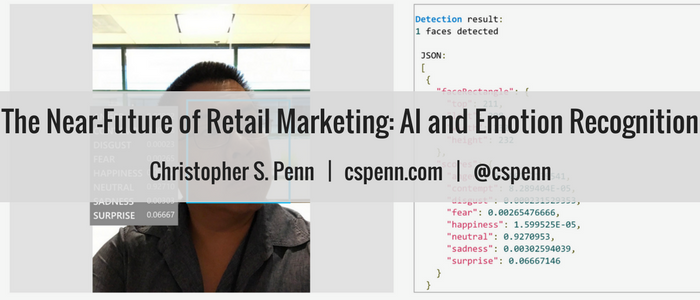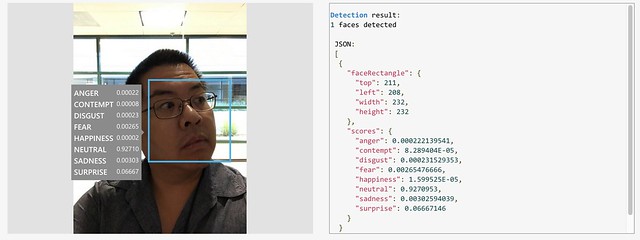Artificial intelligence will impact every industry, every profession. In some cases, rather than replacing people, it will change how people do their jobs. Let’s examine the average retail interaction today.
The Current In-Store Retail Marketing Experience
At any average retail store, we walk in and are greeted – sometimes enthusiastically – by someone who doesn’t know us, and occasionally asked how they can help us. Unless we’re lost, we return the greeting and then go about our business.
What happened here? The store missed a key opportunity to sell us more stuff. No one checked to see who we are, what our past purchase history was, what shoppers like us also bought, how our mood was, and what items might fit that mood.
One might say that amount of personalization is impossible for the average greeter at today’s big box stores and unassisted, that’s true. But what might the greeter of tomorrow do instead?
The Near Future In-Store Retail Marketing Experience
At the store of the near future, we arrive. The cameras from the parking lot to the lobby to the front door of the store (which in many stores are already there) pass velocity data to a video indexing API to analyze our speed. How quickly or slowly we’re walking indicates intent – are we there to browse, or are we in a hurry? Our general outfit and visual fingerprint is passed to the next camera for more in-depth identification.
We walk in. The cameras at the entrance take a photo of our face. That photo is then instantly passed to several different APIs. Using a facial recognition API like Microsoft Face API or Amazon Rekognition, AI instantly recognizes and calls up:
- Who we are
- Our name
- Our purchase history
- Our return history
- Our social networks
In the next heartbeat, the AI uses an emotion recognition API like Microsoft Emotion to determine our state:
The software recognizes not only who we are, but how we might be feeling as we enter the store.
In another instant, a classification and regression model runs, combining all the data that the AI has accumulated. It checks our past history and examines:
- Cyclicality: do we come into the store every X days to buy item Y?
- Seasonality: do we buy certain items every year in a certain month?
- Purchase Patterns: what else have we bought, and how does that match with what others have bought in the past?
- Emotionality: what have others bought in store when they came in with similar emotions?
After using several machine learning models, the AI sends data to either the earpiece the greeter is wearing or perhaps a mobile device. The greeter, positioned after the shopping carts, instead of giving a polite but unhelpful pleasantry, says:
“Good morning Mr. Penn. Nice to see you again. Today, we’ve got a special in aisle 4 on those chocolate-covered espresso beans folks just seem to love.”
While I might thank the greeter politely and move on, inside I’ll be thinking, “Wow – amazing that he knew exactly what would make me feel better!” And, of course, I’ll head to aisle 4 and pick up a bag, even if it wasn’t on my list of things to buy.
The In-Store Experience Will Be Much Better with AI
This is an example of what a store could do just with the cameras at its entrance and some machine learning APIs. Imagine how else we could customize the retail experience with overhead cameras tracking:
- how often individual people pick up items and put them back
- where people walk in the store and how long they spend in front of any given item
- what emotions run across their faces as they browse items
- the emotions of people standing in line – and the AI automatically summoning more staff to help reduce lines the moment it detects a spike in frustration on shoppers’ faces
Here’s the amazing part: everything I’ve described is possible today. These are not far-off future technologies. These are APIs and services available right now, to everyone. The MAGI of AI – Microsoft, Amazon, Google, and IBM – offer similar technologies at very low costs. For the facial recognition and emotion example above, I took a photo of myself at the office door and used my Microsoft developer keys to run the analysis on my laptop with Azure Cognitive Services.
Even a small business, as long as it had access to technical expertise, could construct a system like this. A Raspberry Pi with a video camera attachment costs $45 and, using Python, could communicate all this data to the cloud and back instantly.
The future of the retail experience in-store, for the savviest retailers, will be amazing. Consumers will feel personalized attention and customization like never before, because the store truly will know them and what they want.
You might also enjoy:
- You Ask, I Answer: Retrieval Augmented Generation vs Fine-Tuning?
- You Ask, I Answer: AI Works And Copyright?
- Almost Timely News, February 4, 2024: What AI Has Made Scarce
- Mind Readings: Most Analytics Data is Wasted
- You Ask, I Answer: Retrieval Augmented Generation for Tax Law?
Want to read more like this from Christopher Penn? Get updates here:
 Take my Generative AI for Marketers course! |




Leave a Reply